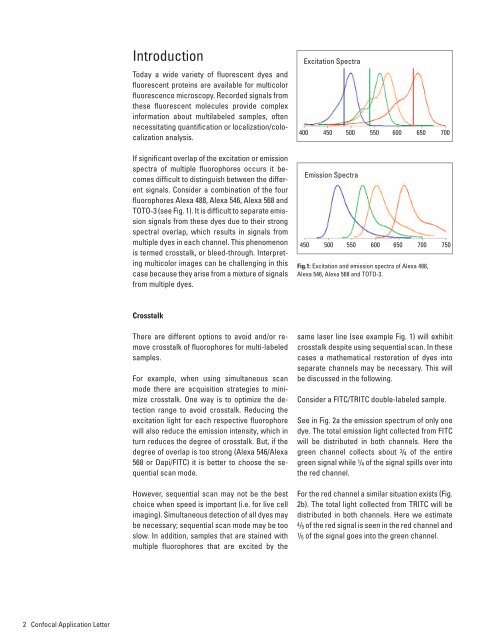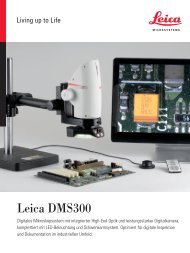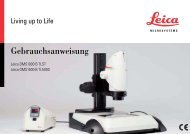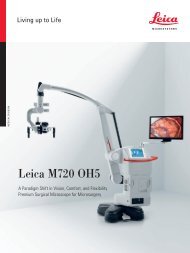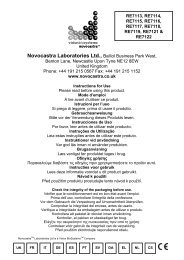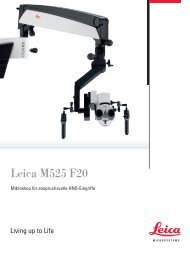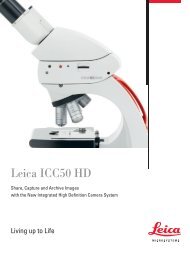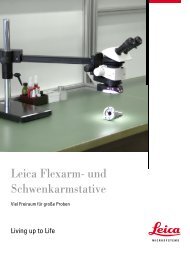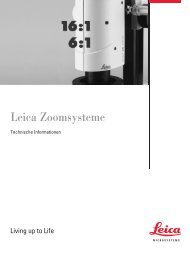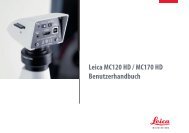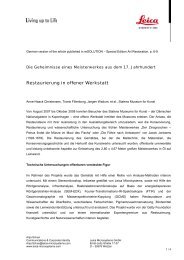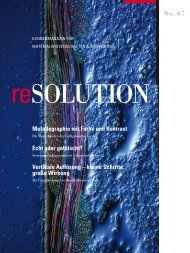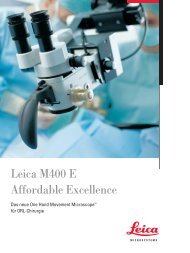Dye Separation - Leica Microsystems
Dye Separation - Leica Microsystems
Dye Separation - Leica Microsystems
Create successful ePaper yourself
Turn your PDF publications into a flip-book with our unique Google optimized e-Paper software.
2 Confocal Application Letter<br />
Introduction<br />
Today a wide variety of fl uorescent dyes and<br />
fl uorescent proteins are available for multicolor<br />
fl uorescence microscopy. Recorded signals from<br />
these fl uorescent molecules provide complex<br />
information about multilabeled samples, often<br />
necessitating quantifi cation or localization/colocalization<br />
analysis.<br />
If signifi cant overlap of the excitation or emission<br />
spectra of multiple fl uorophores occurs it becomes<br />
diffi cult to distinguish between the different<br />
signals. Consider a combination of the four<br />
fl uorophores Alexa 488, Alexa 546, Alexa 568 and<br />
TOTO-3 (see Fig. 1). It is diffi cult to separate emission<br />
signals from these dyes due to their strong<br />
spectral overlap, which results in signals from<br />
multiple dyes in each channel. This phenomenon<br />
is termed crosstalk, or bleed-through. Interpreting<br />
multicolor images can be challenging in this<br />
case because they arise from a mixture of signals<br />
from multiple dyes.<br />
Crosstalk<br />
There are different options to avoid and/or remove<br />
crosstalk of fl uorophores for multi-labeled<br />
samples.<br />
For example, when using simultaneous scan<br />
mode there are acquisition strategies to minimize<br />
crosstalk. One way is to optimize the detection<br />
range to avoid crosstalk. Reducing the<br />
excitation light for each respective fl uorophore<br />
will also reduce the emission intensity, which in<br />
turn reduces the degree of crosstalk. But, if the<br />
degree of overlap is too strong (Alexa 546/Alexa<br />
568 or Dapi/FITC) it is better to choose the sequential<br />
scan mode.<br />
However, sequential scan may not be the best<br />
choice when speed is important (i.e. for live cell<br />
imaging). Simultaneous detection of all dyes may<br />
be necessary; sequential scan mode may be too<br />
slow. In addition, samples that are stained with<br />
multiple fl uorophores that are excited by the<br />
Excitation Spectra<br />
400 450 500 550 600 650 700<br />
Emission Spectra<br />
450 500 550 600 650 700 750<br />
Fig.1: Excitation and emission spectra of Alexa 488,<br />
Alexa 546, Alexa 568 and TOTO-3.<br />
same laser line (see example Fig. 1) will exhibit<br />
crosstalk despite using sequential scan. In these<br />
cases a mathematical restoration of dyes into<br />
separate channels may be necessary. This will<br />
be discussed in the following.<br />
Consider a FITC/TRITC double-labeled sample.<br />
See in Fig. 2a the emission spectrum of only one<br />
dye. The total emission light collected from FITC<br />
will be distributed in both channels. Here the<br />
green channel collects about 3/4 of the entire<br />
green signal while 1/4 of the signal spills over into<br />
the red channel.<br />
For the red channel a similar situation exists (Fig.<br />
2b). The total light collected from TRITC will be<br />
distributed in both channels. Here we estimate<br />
4/5 of the red signal is seen in the red channel and<br />
1/5 of the signal goes into the green channel.


